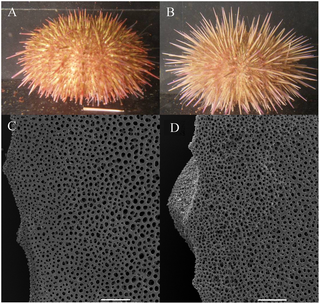Adam D. Hughes*, Lars Brunner, Elizabeth J. Cook, Maeve S. Kelly, Ben Wilson
Department of Ecology, Scottish Association for Marine Science, Oban, Argyll, Scotland
The trophic interactions of sea urchins are known to be the agents of phase shifts in benthic marine habitats such as tropical and temperate reefs. In temperate reefs, the grazing activity of sea urchins has been responsible for the destruction of kelp forests and the formation of ‘urchin barrens’, a rocky habitat dominated by crustose algae and encrusting invertebrates. Once formed, these urchin barrens can persist for decades. Trophic plasticity in the sea urchin may contribute to the stability and resilience of this alternate stable state by increasing diet breadth in sea urchins. This plasticity promotes ecological connectivity and weakens species interactions and so increases ecosystem stability. We test the hypothesis that sea urchins exhibit trophic plasticity using an approach that controls for other typically confounding environmental and genetic factors. To do this, we exposed a genetically homogenous population of sea urchins to two very different trophic environments over a period of two years. The sea urchins exhibited a wide degree of phenotypic trophic plasticity when exposed to contrasting trophic environments. The two populations developed differences in their gross morphology and the test microstructure. In addition, when challenged with unfamiliar prey, the response of each group was different. We show that sea urchins exhibit significant morphological and behavioural phenotypic plasticity independent of their environment or their nutritional status.

Gross morphological (panel A&B) and microstructural differences (panel C&D) in the test of Psammechinus miliaris from the wild type diets (A&C) and the processed diet (B&D).
The sea urchins in panel A&B are approximately 40 mm test diameter. Scale bars on the SEM micrographs represent 200 µm.
Sea urchins are well known for their morphological and behavioural plasticity. It has long been observed that populations from different habitats were morphologically distinct . In addition, sea urchins have shown rapid morphological response to food availability , substrate morphology, the presence of predators and behavioural plasticity over environmental gradients. Sea urchin barrens themselves are one such driver of morphological change, with populations of sea urchins of the same species having different morphologies inside and outside of sea urchin barrens . In order to fully understand the role that phenotypic trophic plasticity in sea urchins plays in maintaining urchin barrens, it is first necessary to demonstrate that this plasticity is truly phenotypic. Secondly, we must show that the phenotypic plasticity is an adaption to the trophic environment unconfounded by other environmental factors, such as nutrient limitation or habitat differences. Thirdly, we need to understand if morphological adaption alters the way in which the sea urchins respond to their trophic environment in terms of prey handling and diet breadth. To do this we examined phenotypic plasticity in an echinoderm species: Psammechinus miliaris. This species is a small regular echinoid with a distribution along the north-eastern Atlantic from Scotland to North Africa. It is known to be strongly omnivorous and to exhibit a high degree of plasticity in the wild . Under controlled laboratory conditions we challenged P. miliaris with two nutritionally equivalent, but physically different trophic environments and examined the nature of their phenotypic response, in terms of any changes in gross and microstructural characteristics and behaviour to their trophic environment.



 November 24th, 2012
November 24th, 2012  Riffin
Riffin  Posted in
Posted in  Tags:
Tags: 